Please Take Note: This is a review of the final game, but it might change slightly based on the success of the Kickstarter campaign. The game is being reviewed on the components and the rules provided with the understanding that “what you see is not what you might get” when the game is published. If you like what you read and want to learn more, we encourage you to visit the game’s website or visit the Kickstarter campaign. Now that we have all that disclaimer junk out of the way, on with the review.
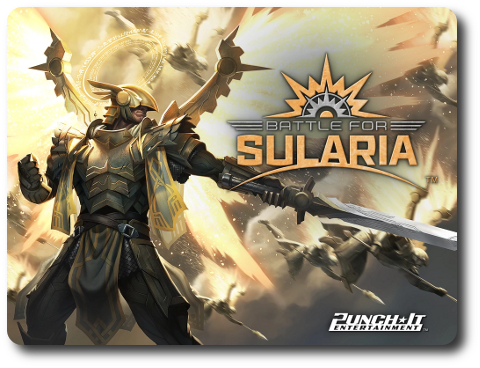
The Basics:
- For ages 10 and up (publisher suggests 13+)
- For 2 players (additional players possible)
- Approximately 30 minutes to complete
Geek Skills:
- Active Listening & Communication
- Counting & Math
- Logical & Critical Decision Making
- Reading
- Strategy & Tactics
- Hand/Resource Management
Learning Curve:
- Child – Moderate
- Adult – Easy
Theme & Narrative:
- Battle to control the last remaining resources on the planet
Endorsements:
- Gamer Geek mixed!
- Parent Geek mixed!
- Child Geek approved!
Overview
Sularia was once a planet of beauty and majesty. The people who populated it lived in peace and prosperity, but that is the past. The vast gardens teaming with life are now dusty plains. The great cities that once reached to the heavens now lay in ruin. You would see your people rise above the death and decay. Gather your forces and battle to claim the precious resources necessary to bring the planet back to life, as your will decrees.
Battle for Sularia, designed by Jesse Bergman, John Kimmel (II), and to be published by Punch-It Entertainment LLC, will reportedly be comprised of 21 Jotune Faction cards (4 copies of each), 21 Synthien Faction cards (4 copies of each), and 3 Mercenary Faction cards (4 copies of each) for a total of 180 cards in what is being positioned as the starting box set. The game will come with 2 preconstructed decks (Jotune faction and Synthien faction) that can be used right out of the box. The additional 60 cards are used to further refine each deck or allow players to create their own. As this is a review of a prepublished game, I will not comment on the game component quality. The illustrations by John Kimmel (II) are excellent, capturing each card’s thematic nature which serves to strengthen the game’s narrative. Not included with the game, but necessary to play, is a means to keep track of player’s “Health” and markers to track certain effects and conditions on cards during the game.
Let’s Talk About the Cards
Being a card game, Battle for Sularia has a lot of cards to use. Not so many as to become easily confused, however. In total, there are only 4 of note and each is used in a unique way, making it fairly easy to quickly learn how to use them. In other words, players are not given a tool box full of many unrecognizable and undefined tools. Each card has a specific job. Each card category is summarized here.
Site Cards
Site cards represent key locations of strategic importance. They are also resource generators. Site cards create a resource called “Sularium” that is used to play and power other cards. Think of them as gas stations that fuel the player’s army, but that is really overly simplifying them.
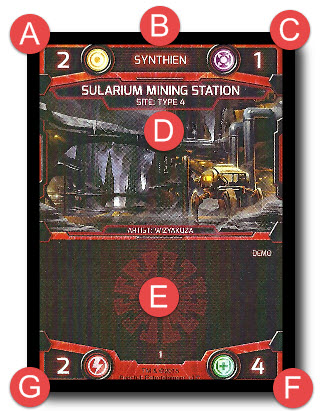
A) The amount of Influence required to bring the card into play
B) Faction name
C) The amount of Sularium the card either adds or subtracts from the player’s Sularium resource pool
D) The card category (in this case, “Site”) and the type (identifies how many cards with the same name can be in the play at any given time)
E) Flavor text and additional abilities or rules that are specific to the card
F) The card’s Defense value
G) The card’s Attack value
Site cards can be brought into play if the player has enough “Influence” to pay for them. Once they are played, they can be used immediately, helping the player’s army advance whatever cause they are fighting for at the moment. One of those causes might be defending the very Site card that just came into play. Luckily for the player, Site cards have an Attack and Defense value, but the Site does not initiate attacks. The Attack value is the amount of damage the Site card inflicts back on attackers and the Defense value is the Site card’s damage capacity (i.e. “Health”, if a location can have such a thing).
Combatant Cards
Combatant cards represent the player’s diverse and well-trained soldiers, specialist, and professionals that take orders and get things done. Combatant cards are brought into play by spending Solarium, which is primarily provided by Site cards. Once in play, the primary role of a Combatant card is to attack and destroy an opponent’s Site and Combatant cards. Like the Site cards, the Combatant cards have an Attack and Defense value. Useful when attacking, but even more so when the Combatant card is tasked to defend a Site card location. In which case, the Combatant card’s Attack and Defense values are used to modify the Site card’s Attack and Defense values.
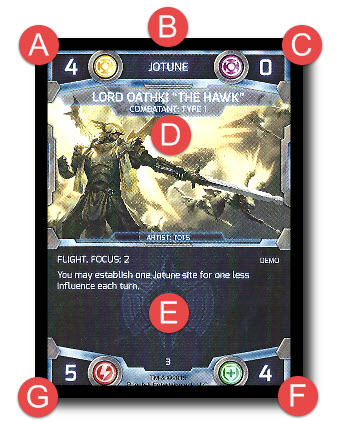
A) The amount of Sularium required to bring the card into play
B) Faction name
C) The amount of Sularium the card either adds or subtracts from the player’s Sularium resource pool
D) The card category (in this case, “Combatant”) and the type
E) Flavor text and additional abilities or rules that are specific to the card
F) The card’s Defense value
G) The card’s Attack value
As powerful as a Combatant card might seem, they are not initially “mission ready”. Once played, they are considered “activated”. This means they cannot be used to attack, defend, or take any action on the same turn they are brought into play.
Tactic/Condition Cards
Technically two different card categories, but their overall use is similar enough to group them together. Not that you’ll want to use the different card categories the same way, mind you…

Tactic card on the left, Condition card on the right
A) The total number of cards the player must have in their Influence row to bring the card into play
B) Faction name
C) The amount of Sularium the card either adds or subtracts from the player’s Sularium resource pool
D) The card category (in this case, “Tactic” and “Condition”)
E) Flavor text and additional abilities or rules that are specific to the card
Tactic cards can be played from the player’s hand or from a special region called the “Influence row” that is in front of the player during the game. For the most part, Tactic cards are played in response to an opponent’s action, but a player can also use them to help with preemptive strikes or fortifying defenses.
Condition cards are very similar to Tactic cards, but for one major difference. While Tactic cards are played and resolved, Condition cards come into play and remain in play for the duration of the game. Think of Tactic cards as one-shot wonders and Condition cards as long-term strategies. Making Condition cards even more useful is their ability to be used as a Tactics card. That’s right, the Condition card can be played to meet immediate needs or to further advance long-term goals. So cool…
Special Cards and Mercenaries
Site, Combatant, Tactic, and Condition cards will make up the bulk of a player’s deck of cards. A handful of other cards will also be included in the game, but their use is significantly different from the majority.
The Influence card can be any card in the game, but it has a special role. It’s played face-down and remains face-down, doing nothing, in the Influence row. It has no special abilities or effects as long as it’s an Influence card. It just counts as “Influence”, a primary resource necessary to get Site cards into play. When the Influence card is revealed, it’s still considered an Influence card, but also takes on the abilities of whatever the card really is. Depending on what that card is, the Influence card will either remain an Influence card (remaining in the Influence row) or jump into play elsewhere. For example, Condition cards revealed in the Influence row remain in the Influence row, while Site and Combatant cards leave and are placed elsewhere.
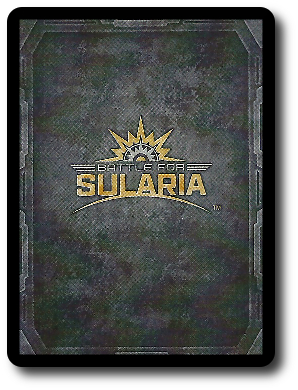
Mercenaries do not belong to any faction. This allows the players to use them in their decks, regardless of what faction they are playing as. Useful when filling in the gaps left by a faction’s less than stellar performance in certain areas of combat, tactics, or site locations. Like Faction cards, Mercenary cards use the same icons and play by the same rules.
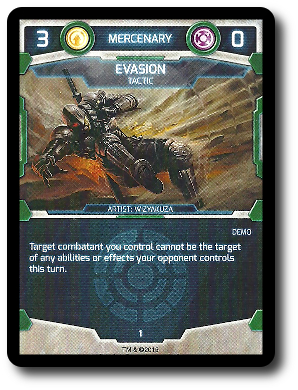
Your Playing Space
Like all card games, players will need a reserved playing area they can call “home”. Battle for Sularia calls this area in front of the player the “Play Zone”, which is comprised of smaller zones, rows, and piles of cards.
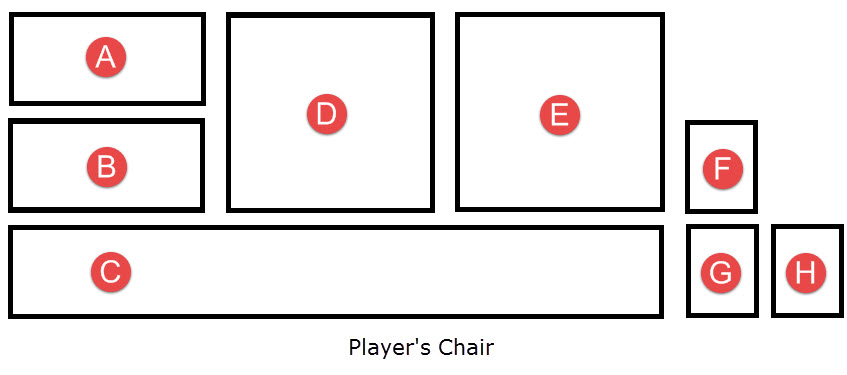
A) Front Site Row: Location where Site cards are placed during the game
B) Rear Site Row: Identical to the Front Site row, but fortified by the Front Site row
C) Influence Row: Location where cards are placed face-down to provide the Influence resource
D) Combatant Zone: Location where Combatant cards are placed when engaging an opponent in combat
E) Hidden Zone: Location where Combatant cards are considered “invisible” and cannot be attacked by normal means until the Combatant cards are used to attack or defend
F) Play Deck: The player places their deck of cards face-down here
G) Damaged Pile: Cards that have taken enough damage to be removed are placed in a pile here, face-up
H) Destroyed Pile: Cards that have been destroyed are placed in a pile here (cards that go here are out for the duration of the game)
The only two rows of note that need to be explained in more detail are the Front and Rear Site rows. When a player places a Site card, they must decide if they will place it in the front or the rear. As you have probably already guessed, Site cards placed in the front protect the Site cards in the rear. An opponent cannot directly attack a Site card that has another Site card in front of it (unless they have an ability that states otherwise). In this way, a player can defend their locations by fortifying them, but careful planning is necessary. When placing a new Site card, it must be adjacent to another Site card already in play. This forces a player to put some Site cards up front and in danger.
Resource Wars
Note: Battle for Sularia is a custumizable card game. As such, I have no way of possibly knowing what cards you might or might not have in your deck. Each card brings its own rules to the game, allowing the player to take actions that are not provided by default or available to their opponent. Additionally, the game makes use of keywords that further define how cards interact with each other, forming new abilities. As such, I will summarized the game here, providing the general framework from which the game is hung and battles are fought. I’ll be glossing over some finer points that are best left to the rule book.
Battle for Sularia is played in rounds and turns. Each player’s turn is broken down into multiple phases. Once both players have taken their turn, a round is completed. A player’s turn is summarized here. During each player’s first turn, the Reset Phase and Draw Phase are skipped. Players should also take note of their card effects and be sure to trigger them during specifically named phases of the game. Some triggered effects are mandatory and the player has no say if they are used or not. Some triggered effects are optional. Depending on which type the triggered effect is, a player may or may not be able to respond to them.
Before playing, each player shuffles their Play deck of cards, draws 7, and sets their “Health” to 25. The game now begins with the first player.
Reset Phase
At the start of the player’s turn (except the player’s very first turn), any cards that are in play (rotated 90 degrees) are reset to their original position (rotated back to a normal vertical placement). These cards are now considered “Ready” and can be used.
Draw Phase
The player can now draw up to 2 cards from their Play deck (unless this is the player’s first turn) and adds them to their hand.
Influence Phase
Any card the player has in their hand can be played face-down to the Influence row. The most commonly used card categories placed in the Influence row are Tactics and Conditions, but Site and Combatant cards can also be used. Cards placed here will add to the player’s Influence resource pool.
Site Phase
The player can now play as many Site cards as they like as long as the total Influence cost does not exceed what is provided by the cards they have in play already (most of the time, the primary Influence source will be the Influence row). The player should take a moment to consider how best to place their Sites, since each Site card must be adjacent to another Site card.
Sularium Phase
The player now takes a moment to quickly determine the total amount of Sularium generated by their cards in play. This amount is the player’s Sularium pool for their turn.
Combatant Phase
The player can now play as many Combatant cards as they like as long as the total Sularium cost does not exceed their total Sularium pool value. Combatant cards come into play activated (rotated 90 degrees), meaning they cannot be used to attack an opponent when they first come into play. Combatants can be deployed to the Combatant Zone.
Attack Phase
The player can now declare an attack on their opponent, but only those Combatants that are not activated can be used. Combat is slightly involved, but pretty quick to learn.
- Declare attacking Combatants and rotate them 45 degrees
- All attacks must be declared at one time and Combatants can attack different targets (two or more Combatants attacking the same target makes them a “Joint Strike Force”)
- Opponent declares defending Combatants and rotates their cards 45 degrees
Each of the targeted Sites and engaged Combatant cards are now resolved. Damage happens simultaneously, meaning 2 opposing cards both hit and defend at the same time. This means it’s likely that some attacks will result in both players losing their cards.
The Attack Phase also uses a method of ordering actions referred to as a “Command Chain”. The attacking player plays an action and the defender then has the option to respond. This goes back and forth until all the abilities on the cards engaged in combat have been activated and resolved using the “First In, Last Out” method of resolution.
Targets and damage hit Combatants first, followed by Sites, and then the player. When a Combatant has attacked and defended, they are rotated another 45 degrees signifying that their part in the battle has been resolved. Cards that have their Health reduced to zero (The opponent’s Attack value is equal to or grater than the card’s Defense value) are placed in the Damage pile. Players should take note of any special abilities and keywords when determine the outcome of a battle, as well. There are a number of different damage types and ways to fly over targets or simply blast through them.
If the player no longer has any Combatants or Sites in front of them, any damage dealt during combat reduces the player’s Health.
Discard Phase
The player now counts the cards in their hand. They must discard down to no more than 7 cards, placing the discarded cards in their Damage pile.
This ends the player’s turn. The next player in turn order sequence now goes starting with the first phase of their turn.
The Planet is Yours…for Now
The game continues until 1 player’s Health is reduced to zero. The planet has been won and the victor controls all the resources for the time being.
Roll Your Own Faction
Battle for Sularia will come with 2 precontructed decks, representing 2 different factions, and a handful of other cards that can be used as a sidebar or to modify the suggested starting cards to play with. In the future (if all goes well with the game), players will have an opportunity to build their own decks representing the faction of their choice. The rules to create a deck are fairly simple, making it easy for inexperienced deck-builders to give it a try. Learning how to build a deck is essential for those players who want to combine different cards to create powerful combos.
- A player’s deck can consist of no more than 60 cards
- A player’s deck cannot be worth more than the agreed upon total point value (normally 90 points)
- Players should not skimp on the Site cards unless they want to be short of the Sularium resource
- Sites need protecting, so don’t forget to bring an army
- Condition and Tactics cards are great for handling specific situations, but they are always perfect for providing the Influence resource
Not a lot of details have been released yet regarding more advanced deck-building techniques, but the rule book promises that more is to come.
To learn more about Battle for Sularia, visit the game’s website or visit the Kickstarter campaign.
Final Word
Only the older Child Geeks were able to play this game. Even then, the learning curve was moderately steep. The biggest issues the Child Geeks had was the multiple areas to play cards to and the sometimes complex Command Chain, resolving actions and effects using the correct timing. Nothing terribly difficult, mind you, but enough to make the Child Geeks who liked more casual games run for the hills. Those that remained were the Child Geeks already familiar with deck-building games and how they were played. According to one of these Child Geeks, “The game is pretty tricky to learn at first, but after a couple of turns, it’s pretty easy.” Another Child Geek said, “I like that you build your empire out in front of you. I know exactly what I want to attack and what I want to defend.” Tactical and strategic game play was apparent, battles were swift, and victories were hard-won. Still, the Child Geeks were not in love with the game at first. According to one Child Geek, “I don’t know. The game is OK. I’m just not really liking it yet.” Another Child Geek said, “I don’t feel like I’m any of these characters.” In the end, the Child Geeks decided what they liked about the game far outweighed what they didn’t and voted to approve Battle for Sularia.
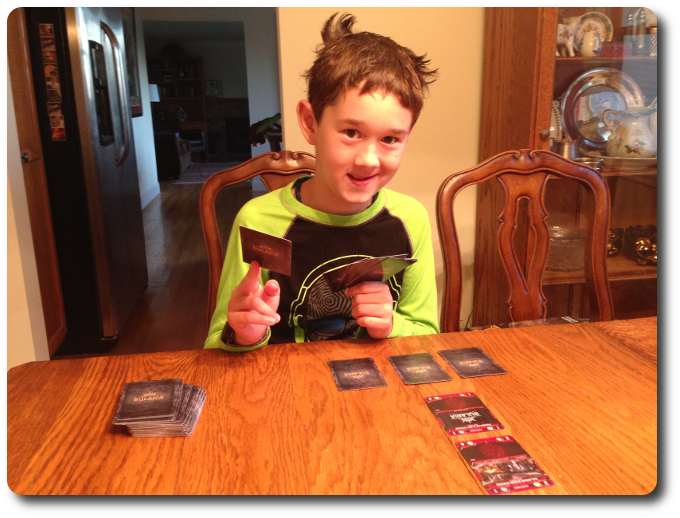
My oldest son really enjoyed the game – especially when he kept kicking my butt
The Parent Geeks, especially those who are more than just casual gamers, quickly learned the game and got to business. Like the Child Geeks, tactical and strategic game play was apparent which left me wondering if Battle for Sularia was a game that made it really easy to use Tactic and Condition cards or the players were just that good. One Parent Geek had the same question and said, “I think this is a game that welcomes you to try new things. I really like that. The game feels very open to me.” Another Parent Geek said, “For the most part, the game feels very intuitive. The keywords are kind of a mess, but I bet that will be cleaned up when the game is released. For what it is, I like it.” But not all the Parent Geeks enjoyed their time on Sularia. One Parent Geek said, “This game is a mess. I place cards here, I place cards there. I tip and than I tap, shuffle and then flip. Ugh! Too busy!” Another disgruntled Parent Geek said, “I don’t feel like this game is really challenging me or introducing something new other than just a new way to name resources and places to set cards.” When all the votes were in, Battle for Sularia was found to be a game that the Parent Geeks neither approved or disproved of.
The Gamer Geeks picked this game apart like hungry lions. They found many aspects they didn’t like and many they did. From the positive pile, the Gamer Geeks liked the three different tiers of resources and requirements the players had to manage, they enjoyed the combat and the tactical way you decided how it was executed, and the layered Site card placement which provided additional defensive capabilities. The Gamer Geeks did not like how watered down the different factions were, finding them to be too general without any unique characteristics. The Gamer Geeks also didn’t care for the game in general. A number of them found Battle for Sularia to be boring or uninteresting. According to one Gamer Geek, “I don’t know. The game isn’t really doing anything for me. It just feels like another deck-builder that is trying to tell you it’s different than all the other deck-building games out there when it really isn’t.” But this sentiment was not shared by all. Another Gamer Geek said, “I really like what this game is doing and how it’s going about it. The different resources force to me map out my plans, the different combos challenge me to consider my timing, and the Influence row is always making me wonder if I put the wrong cards there or not. I’m really liking this.” Overall, and very much like the Parent Geeks, the votes from the Gamer Geeks left Battle for Sularia with a mixed review. The game had its proponents and its opponents in equal measure.
For those individuals who enjoy theorizing and continually revamping their deck of cards, Battle for Sularia should be fun, but not overly difficult. The different resources will trip up new players, but experienced deck-builders will quickly realize that resources come in pairs and cards often give back what they take. The recommended ratio of card categories for a standard 60 card deck is roughly 1/3 Tactic/Condition cards, 1/3 Site cards, and 1/3 Combatant cards. Without having more cards to test the recommendation and come up with our own formula, we have to take the game designer’s word that the ratio is sound. I see no reason to disagree, but would put more into my Tactics and Conditions and less in my Site cards to better match my playing style. Still, there were enough cards provided to peek the interest of our deck-builders, which is a good sign.
A good deal of emphasis is put on the two primary resources in the game: Influence and Sularium. Both are important and each is brought into play in a unique enough way to make them standout. Influence is primarily provided by the Influence row, while Sularium is provided by Site cards. This challenges a player to maintain two different resource nodes, growing both, while balancing their expansion with the needs to engage in conflict. Thematically, it puts the player in a tight spot. They must have enough influence to lead their people and then find enough resources to equip their army. But wait, there’s more. Tactic and Condition cards list a Threshold Cost, which is not so much a resource requirements, but a cards-in-play requirement. The player must have an equal number or greater number of cards in their Influence row to use a Tactic or Condition card from their hand or reveal a card already in their Influence row. Essentially, this mimics the player’s overall power base. If they don’t have it, they can’t hope to pull off a tactical ploy or hope to take advantage of changing battlefield conditions. A neat twist that will engage new and veteran players from the start.
I personally didn’t find Battle for Sularia as interesting as some of my Gamer Geek peers did. While I appreciated the game’s ease of play, tactical thinking, and strategic actions, the game itself wasn’t feeling like anything new. I’ve played many games where building a deck is required, then you fight an opponent, and then you go back to tweak your deck. Battle for Sularia is no different from all the rest in this respect. I was also disappointed that the game’s theme and narrative didn’t play itself out on the table. The game has a rather detailed backstory that I never felt was leverage in the game short of Faction card titles and illustrations. A shame, as one of my favorite things to do is to make a themed deck. As it stands now, the themes are anchored on the faction and go no further. The end result is that you don’t feel like you are commanding a unique deck of cards.
But let’s be fair.
Battle for Sularia is destined for expansions. Only 2 of the 5 factions were represented enough to provide a glimpse of what the game will possibly be. Without knowing more, I cannot form an educated opinion of the game. Further more, games like Battle for Sularia (and deck-building games in general) tend to release with a small set of cards to get players started. The real “meat and potatoes” of the game lies in the expansions that allow players to experiment with new tactics and develop new strategies.
It’s called “marketing”.
So, where does that leave us? Hanging, my friends. Hanging. What I played and observed leads me to believe that Battle for Sularia is a descent game in the making. All signs point to a good time, but signs and portents don’t hold much water with me. It’s a game to watch, to be sure, but not a game that I think I have fully played yet. It’s like there’s a meal being made in the kitchen, but all I can do is smell it cooking. I have no idea how much I will enjoy it until I get to the table and devour the whole thing. This is a game I have yet to fully bite into. Until then, I rest easy knowing that Battle for Sularia is tantalizing enough to keep me interested and wanting to experience more.
This is a paid for review of the game’s final prototype. Although our time and focus was financially compensated, our words are our own. We’d need at least 10 million dollars before we started saying what other people wanted. Such is the statuesque and legendary integrity of Father Geek which cannot be bought except by those who own their own private islands and small countries.



